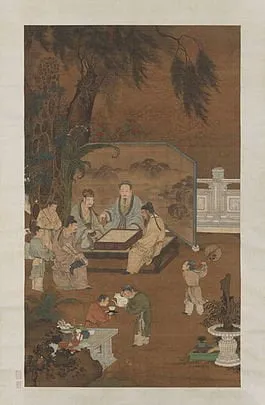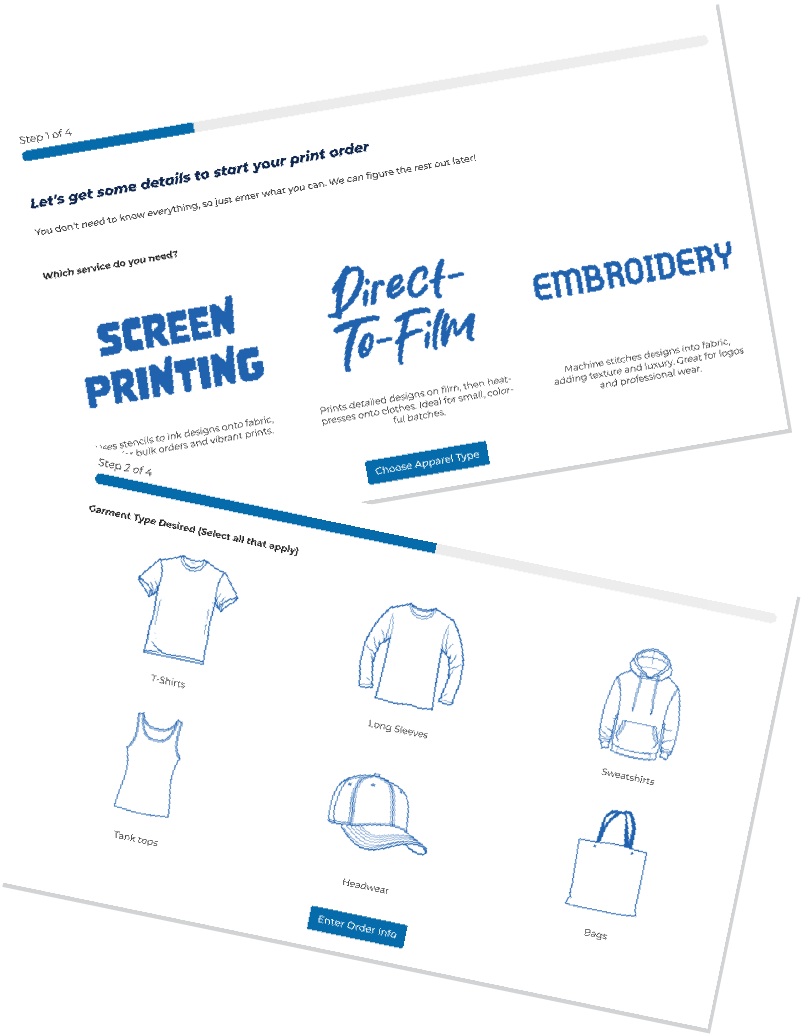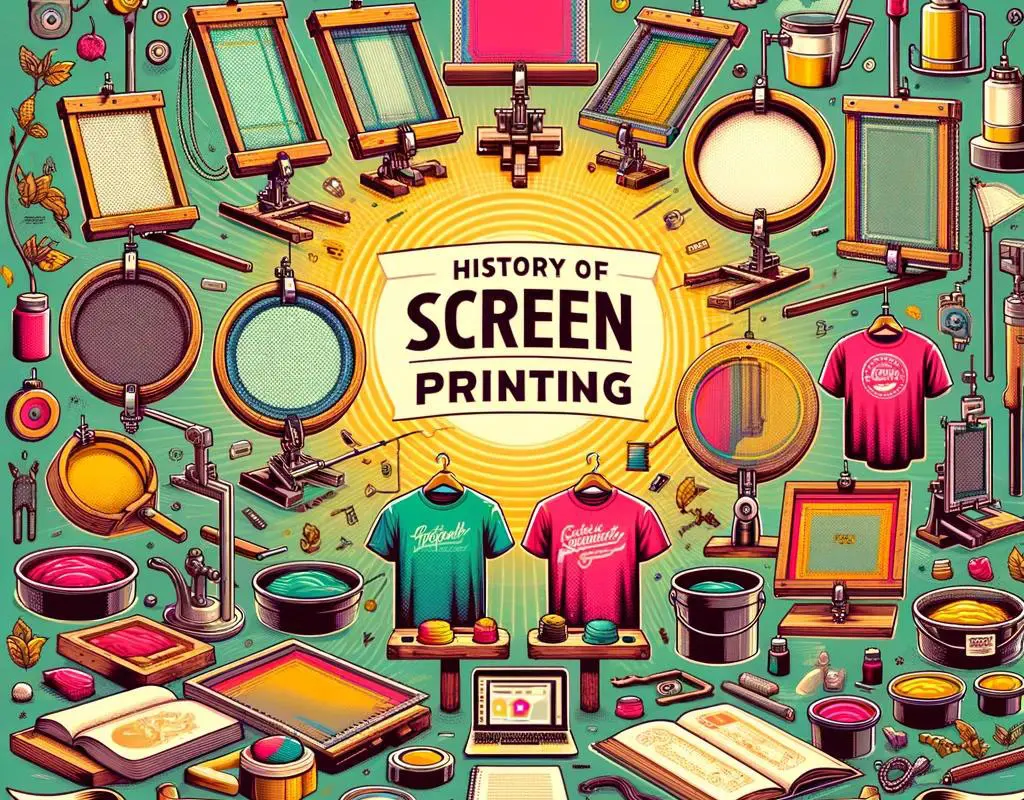Have you ever wondered how your favorite colorful t-shirt got its vibrant design?
Screen printing’s roots trace back to ancient China, revealing a rich history behind the vivid prints we see today.
We will uncover its storied past and explore modern techniques. Our journey will show you the transformation of screen printing into an art and industry staple.
DESIGN YOUR OWN APPAREL

Key Takeaways
- The history of screen printing started over a thousand years ago in ancient China during the Song Dynasty. Craftsmen used silk stencils to print intricate designs onto fabrics.
- By the late 1900’s, screen printing had reached Europe. Thanks to silk screens’ strong and fine mesh, it became famous for creating detailed images on fabric and paper.
- In the 1960s, artists such as Andy Warhol brought screen printing technique into the art world. In contrast, Michael Vasilantone’s multicolor screen printing machine revolutionized the embellishment industry. This was an invention.
- Modern screen printing uses digital technology and eco-friendly inks. Innovations include creating electronic circuits with prints. They also use PVC-free inks for better environmental health.
- Today’s screen printers use advanced machines that are faster, smarter, and safer. Over half of U.S. screen printing is used for making vibrant garments like t-shirts.

Origins of Screen Printing
Diving into the history of screen printing uncovers a fascinating journey that began over a thousand years ago. It’s a tale entwined with ancient craftsmanship.
Simple stencil techniques planted the seeds for what would eventually spread across continents. These techniques evolved into an art form embraced by cultures worldwide.
Silkscreen in the Song Dynasty
In an era marked by refined arts and innovation in China, screen printing emerged as a transformative craft. We witnessed artisans transferring intricate designs onto luxurious fabrics during this period.
They did it with skill. They set a precedent for the sophisticated textile patterns we still celebrate today.

Introduction to Western Europe
Screen printing’s journey to Western Europe was a pivotal moment in history. It all started in the late 18th century, a time of great curiosity and invention. Artists and creators searched for new ways to express themselves and efficiently produce designs.
This search led them to embrace silk mesh, an innovative tool borrowed from Asian countries like Japan.
Europeans saw the potential of this technique beyond simple replication. They refined it, experimented with materials, and applied their artistic flair. The use of mesh as part of the screen printing process became widely accepted across Europe.
In these early days, every print was a step towards revolutionizing how we create art and share ideas through images on fabric and paper.
European innovators pushed the boundaries further with each passing year. They set the stage for screen printing to become one of the most popular forms of expression around the world.
Stencil Process
Screen printing starts with a stencil, a vital tool for creating sharp images on different materials. It keeps ink from going through certain parts of the mesh. Long ago, people used silk to make stencils.
Today, they use modern threads like polyester or even metal.
The stencil shapes the design by blocking areas on the screen. The ink goes onto other parts and the printed fabric or object. This method works well for many items, from apparel to balloons.
Transfer of Designs onto Fabrics
Screen printing in China was a game-changer for fabrics. Artisans used a mesh to press designs onto textiles carefully. They lay block stencils on the fine silk screen, then push ink or dye over them.
This method lets them create detailed patterns and images on cloth.
Silkscreen became their go-to technique for gorgeous garments and impressive artwork. Each color needed its stencil, building up layers of design on the fabric.
The result was intricate, colorful prints that stood out beautifully against plain materials.

WE HELP YOU MAKE AMAZING CUSTOM PRINTED TEES & APPAREL!
CUSTOM IS COMPLICATED
WE MAKE IT EZ
Let our dedicated team help guide you! Click below to send us basic information to get your order started!
Adoption of Screen Printing in Europe
Screen printing’s journey across the continent transformed it from a novel curiosity to an essential tool of European craft and industry. Don’t miss how this fascinating story unfolds.
Late 18th Century Developments
Silk became a game-changer for the history of screen printing once it hit Europe in the late 1700s. This new material made it easier to print more detailed and delicate designs.
People found that silk mesh was stronger and finer than other materials they used before.
Because of this, artists and printers could create higher-quality images on fabrics and paper.
This time marked a turning point as screen printing started to catch on across Europe. With silk now widely available, the technique spread quickly among creators looking for new ways to make art and share ideas.
They saw how versatile screen printing could be—and they loved it!
Significant Popularity Gain
Screen printing took the world by storm in the 1960s and 1970s. Artists like Andy Warhol used this method to create iconic pieces, such as his Marilyn Monroe portraits.
This new wave of creativity showed how screen printing could go beyond textiles and into art galleries.
People saw a familiar technique in a bold new light.
The industry itself transformed with Michael Vasilantone’s invention. His multicolor screen printing machine changed garment printing forever. Business owners and artists embraced the technology for its efficiency and vibrant results.
Everyone wanted a piece of this colorful revolution—for fashion, posters, and more!
The 1960s Screen Printing Boom
The 1960s ignited a screen printing explosion. Visionaries brought this craft into the limelight. They transformed it from a simple technique to high art.
Influences of Pop Artists like Andy Warhol and Roy Lichtenstein
Andy Warhol turned everyday images into high art using screen printing. His iconic portraits of Marilyn Monroe and Campbell’s soup cans changed how people saw ordinary objects. Similarly, Roy Lichtenstein magnified comic strips with the same technique. He created bold paintings that blurred the line between commercial graphics and fine art.
These artists chose screen printing for its ability to produce bright colors and sharp edges.
Their work inspired a generation to see screen printing as an artistic technique rather than just industrial use. Fashion designers started putting pop art on clothing; musicians wanted it on their album covers.
This sparked a revolution in garment decoration. Exciting designs were printed across t-shirts and dresses everywhere.
Screen Printing Process
Delving into the printing method is akin to watching a choreographed dance. Every subtle movement matters. It starts with the careful application of emulsion on the silk. Then, the precise pressure of the squeegee glides across.
Here, one can truly appreciate the intricate interplay of materials and techniques. It brings vivid designs to life on various surfaces.
Use of Silk and Emulsion
Silk was once the go-to material for screen printing, creating a fine mesh that ink could pass through onto fabric. Today, printers have turned to synthetic materials like polyester and nylon.
These newer threads are strong and work well for modern screen printing needs. A particular substance called emulsion plays a significant role, too. It coats the synthetic mesh, hardening in places where no ink should pass through.
Screen printers use a light-sensitive emulsion to create their designs on screens. The process involves spreading this emulsion over the mesh and exposing it to light with a stencil.
Wherever light hits, the emulsion hardens; parts hidden by the stencil stay soft and can be washed away. This leaves behind an exact area of mesh shaped just like the image they want to print—ready for ink to make its mark on t-shirts, posters, or even wallpaper.
Garment Printing
Apparel printing has come a long way since its early days. American entrepreneur Michael Vasilantone changed the game in 1960. His invention was the multicolor screen printing machine.
This innovation made it easier to print vibrant designs on clothing and fabrics. It sparked a revolution in the fashion and advertising industries.
The process is simple yet effective. A screen is stretched over a frame, and an image is printed onto the fabric by forcing ink through the mesh. Plastisol is often used for commercial garment decoration. It’s durable and adaptable. It can be made softer or heavier depending on what’s needed.
With this technique, everything from t-shirts to tote bags gets a splash of color and personality!
-
 Hanes Beefy-T® T-Shirt$5.10 – $9.35
Hanes Beefy-T® T-Shirt$5.10 – $9.35 -
 American Apparel Fine Jersey Tee$4.55 – $7.80
American Apparel Fine Jersey Tee$4.55 – $7.80 -
 American Apparel CVC Tee$4.67 – $7.19
American Apparel CVC Tee$4.67 – $7.19 -
 American Apparel Heavyweight Cotton Long Sleeve Tee$6.02 – $13.49
American Apparel Heavyweight Cotton Long Sleeve Tee$6.02 – $13.49
Evolution of Screen Printing in the Modern World
Screen printing has woven itself through history. Its evolution doesn’t cease to amaze. Today, we witness a convergence of tradition and high-tech innovation. The modern world greets us with advanced digital techniques and eco-friendly inks. They refine the quality and reflect our growing environmental consciousness.
Latest Techniques and Innovations
Screen printing is leaping into the future with cutting-edge innovations. Imagine using your shirt as a circuit board; that’s what advanced screen printing makes possible today. Printers lay down conductors and resistors on thin ceramic layers. This turns fabrics into multi-layer circuits.
This takes the usefulness of screen printing way beyond just cool designs.
Digital hybrid screen printing merges old-school techniques with digital technology. This mix lets you create unique customizations without losing the classic touch of analog printmaking.
Artists and manufacturers are creating new kinds of inks, too. They’re crafting eco-friendly inks. These inks are PVC and phthalate-free. They replace traditional plastisol but keep its vibrant look and feel.
These new methods open up endless possibilities for designers to experiment while being kinder to our planet.
Screen Printing Today
Screen printing thrives in various industries today. Over half of the screen printing in the United States goes into making cool shirts and stylish garments. This process also decorates snowboards, labels products, and even prints on medical devices.
Artists and businesses love using screen presses for their vibrant colors and sharp details.
New technologies shape how we print now. Machines got faster and more intelligent, reducing the time it takes to make a print. Inks have changed too; many are now PVC and phthalate-free to protect our health and planet.
These advances mean that printing on a shirt or a skateboard is quicker, safer, and more eco-friendly than ever before.
Conclusion
The art of screen printing has journeyed through centuries, adapting and thriving with each era. From ancient China to Warhol’s vibrant portraits, this craft blends tradition with innovation.
Today, it touches every corner of our lives, from our clothes to the posters on our walls. Technological advances push its boundaries further. This makes screen printing a timeless yet modern form of expression and industry.
It is a testament to human creativity—constantly evolving yet rooted in history.
FAQs
Q: Who started screen printing, and when did it begin?
Englishman Samuel Simon started the first patent in screen printing around 1907. He used screens and bristle brushes to print beautiful designs.
Q: Did silk always play a role in screen printing?
You bet! Silk was used in early silkscreen printing presses before other materials joined the game.
Q: Is there a link between art and screen printing?
Absolutely! Artists like Sister Mary Corita Kent took screen printing beyond words on shirts—they made true art pieces!
Q: What is the history of screen printing?
Screen printing, also known as silkscreen printing, has a rich history dating back to ancient China. Silk screens were used for printing. It revolutionized commercial screen printing. This moved the process from industrial use to a method that could be done on a much smaller scale.
Q: How is the screen printing press used in many applications?
A screen printing press is used in many applications. It prints tees and apparel, creates fine art prints, and is used in industrial applications. For example, printing circuit boards and electronics.
Q: What is the process of silk screen printing?
A: Silk-screen printing involves pushing ink through a fine mesh screen to transfer a design onto a substrate. The screen is washed after each use, and the tension of the mesh is crucial for accurate and consistent printing.
Q: How did screen printing evolve over time?
A: Screen printing has evolved from its early roots to include modern techniques and materials. Today, screen printing can be done using PVC and phthalate-free ink. Artists and designers use screen printing to print their designs onto a variety of surfaces.
Q: How does screen printing differentiate in artistic application?
Screen printing allows artists to create intricate designs and patterns. They use different screens and inks to achieve various effects. It provides the ability to write, draw, and apply artistic elements to the printed design.
Q: What are the environmental considerations in screen printing?
Screen printing has evolved to include environmentally conscious practices. For example, it uses water-based ink and adopts sustainable techniques. Organizations like the National Environmental Assistance Center provide resources. They help screen printers reduce their environmental impact.
Q: How did screen printing revolutionize the commercial industry?
Screen printing revolutionized the commercial printing industry. It enabled mass production of designs and images on various surfaces. This made it a popular choice for advertising and branding.








